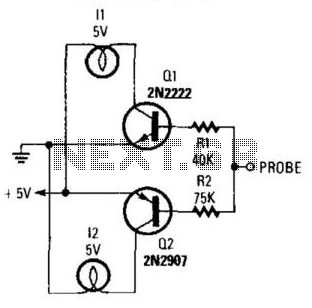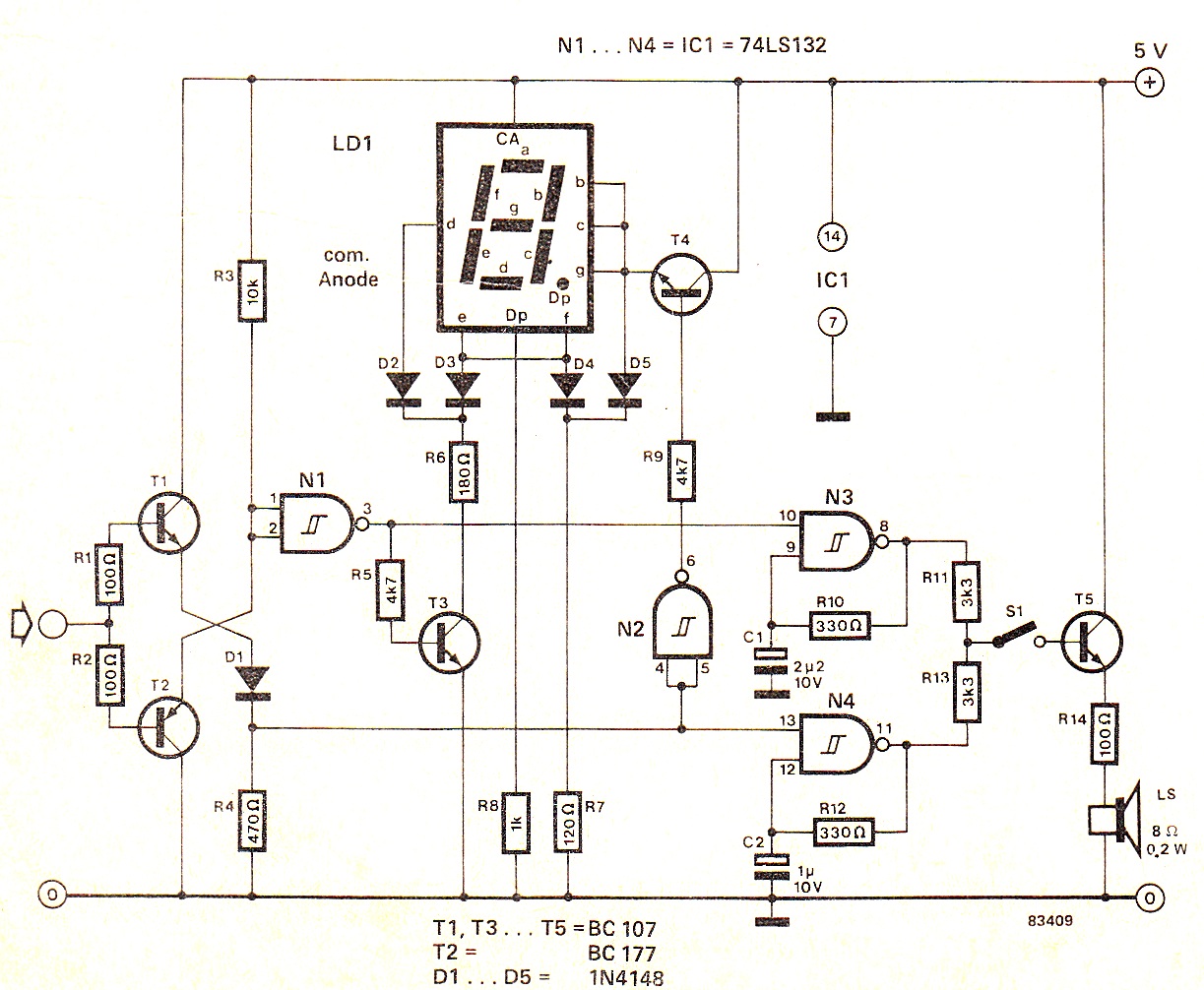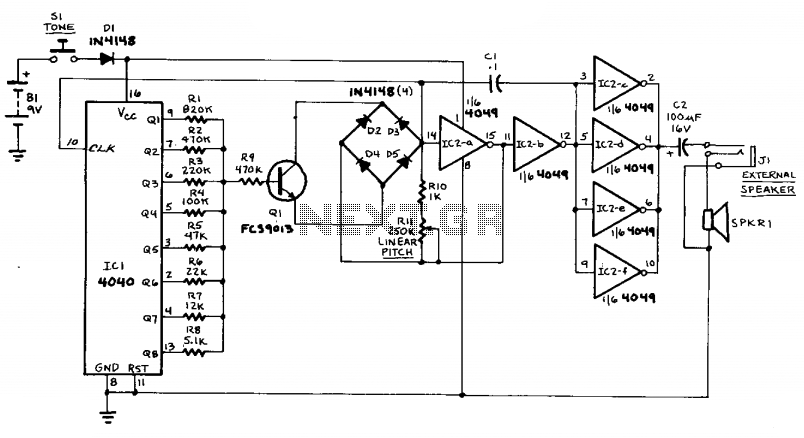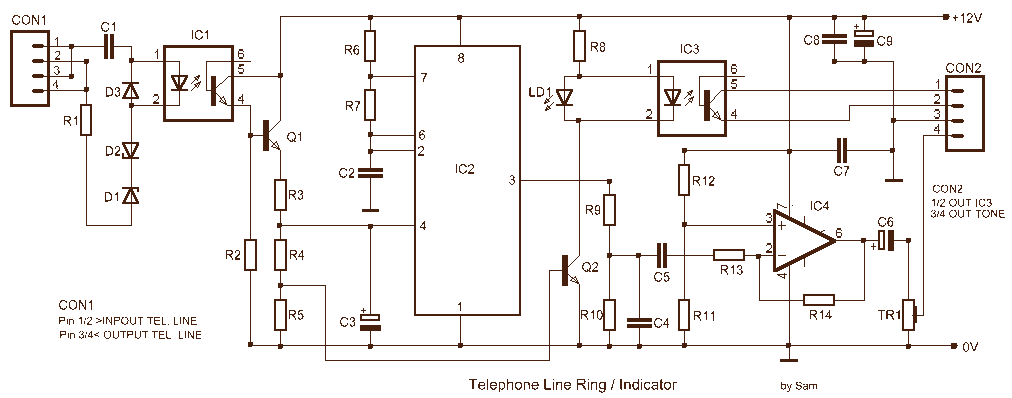
Logic Probe With Sound
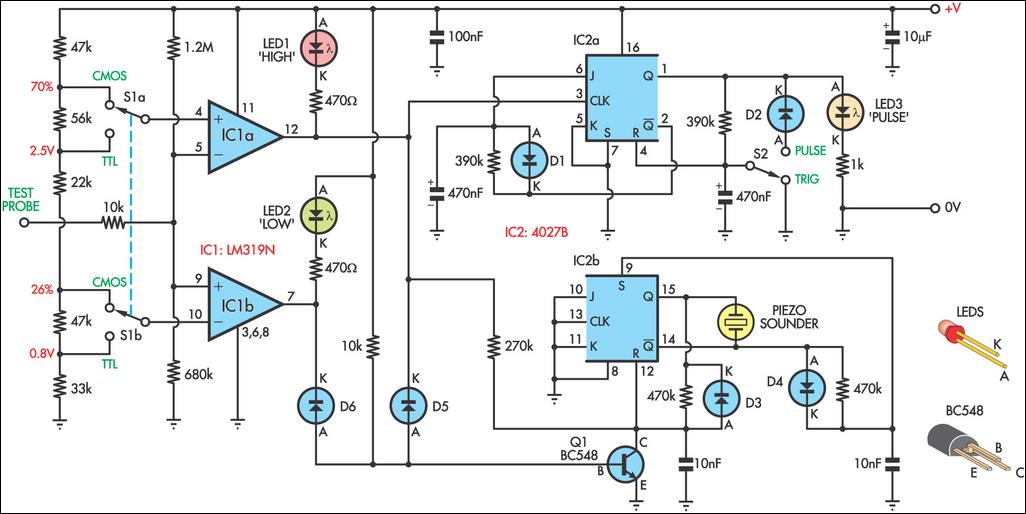
This logic probe can be configured to operate on either TTL or CMOS logic levels using switch S1. A series of resistors connected to switch S1 establishes the threshold levels for a window comparator made up of IC1a and IC1b. Depending on whether the input to the probe is high or low, the window comparator activates LED1 (for high) or LED2 (for low). Resistors of 1.2M and 680k set the probe signal to a midrange value when the probe is open-circuit, preventing either LED from illuminating. If a pulse signal is detected, the output of IC1a will toggle the clock input of flip-flop IC2a, which drives LED3. This LED can either light up for each pulse or continuously, based on the configuration of switch S2. Additionally, the outputs of IC1a and IC1b are connected through diodes D5 and D6 to the base of transistor Q1, which is linked to the Reset input of flip-flop IC2b. This configuration includes a piezo sounder (not a buzzer) connected between the Q and Q-bar outputs, producing a sound that corresponds to the input pulse signal.
The logic probe circuit is designed to provide visual and audible feedback for digital signals, making it a versatile tool for troubleshooting and testing electronic circuits. The selection between TTL and CMOS logic levels allows for flexibility in applications, as different digital devices may operate on different voltage levels.
The use of a window comparator, implemented with operational amplifiers IC1a and IC1b, ensures that the logic probe can accurately differentiate between high and low logic levels. The resistors connected to switch S1 are critical in defining the threshold voltages that determine the logic state, thus allowing for precise operation in various environments.
When the probe is in an open-circuit condition, the midrange value established by the 1.2M and 680k resistors keeps both LEDs off, indicating that no signal is present. This feature is important to avoid false readings when the probe is not in contact with a circuit.
Upon detecting a pulse signal, IC1a's output toggles the clock input of flip-flop IC2a, which in turn controls LED3. The option to configure LED3 to either blink with each pulse or remain lit continuously provides users with a choice based on their monitoring needs. This adaptability enhances the usability of the probe in different testing scenarios.
Furthermore, the integration of diodes D5 and D6 in the circuit protects the integrity of the signals being fed to transistor Q1, which is responsible for resetting flip-flop IC2b. The piezo sounder connected to the outputs of IC2b provides an audible indication of the pulse signal, which can be particularly useful in noisy environments where visual indicators may be overlooked.
Overall, this logic probe circuit is an effective solution for monitoring digital signals, combining visual and audible indicators for enhanced functionality in electronic diagnostics.This logic probe can be selected to operate on TTL or CMOS logic levels, depending on switch S1. A string of resistors associated with switch S1 sets the threshold levels for a window comparator comprising IC1a and IC1b. Depending on whether the level applied to the probe is high or low, the window comparator turns on LED1 (high) or LED2 (low).
Th e 1. 2M and 680k resistors set the probe signal to a midrange value when the probe is open-circuit, thereby preventing either LED from being lit. If a pulse signal is present, the output of IC1a will toggle the clock input of flipflop IC2a. This drives LED3 which either lights for each pulse or continuously, depending on the setting of switch S2.
Finally, the outputs of IC1a & IC1b are connected by diodes D5 & D6 to the base of transistor Q1 which is connected to the Reset input of flipflop IC2b. This has a piezo sounder (not buzzer) connected between its Q and Q-bar outputs so that it produces a sound which echoes the input pulse signal.
🔗 External reference
The logic probe circuit is designed to provide visual and audible feedback for digital signals, making it a versatile tool for troubleshooting and testing electronic circuits. The selection between TTL and CMOS logic levels allows for flexibility in applications, as different digital devices may operate on different voltage levels.
The use of a window comparator, implemented with operational amplifiers IC1a and IC1b, ensures that the logic probe can accurately differentiate between high and low logic levels. The resistors connected to switch S1 are critical in defining the threshold voltages that determine the logic state, thus allowing for precise operation in various environments.
When the probe is in an open-circuit condition, the midrange value established by the 1.2M and 680k resistors keeps both LEDs off, indicating that no signal is present. This feature is important to avoid false readings when the probe is not in contact with a circuit.
Upon detecting a pulse signal, IC1a's output toggles the clock input of flip-flop IC2a, which in turn controls LED3. The option to configure LED3 to either blink with each pulse or remain lit continuously provides users with a choice based on their monitoring needs. This adaptability enhances the usability of the probe in different testing scenarios.
Furthermore, the integration of diodes D5 and D6 in the circuit protects the integrity of the signals being fed to transistor Q1, which is responsible for resetting flip-flop IC2b. The piezo sounder connected to the outputs of IC2b provides an audible indication of the pulse signal, which can be particularly useful in noisy environments where visual indicators may be overlooked.
Overall, this logic probe circuit is an effective solution for monitoring digital signals, combining visual and audible indicators for enhanced functionality in electronic diagnostics.This logic probe can be selected to operate on TTL or CMOS logic levels, depending on switch S1. A string of resistors associated with switch S1 sets the threshold levels for a window comparator comprising IC1a and IC1b. Depending on whether the level applied to the probe is high or low, the window comparator turns on LED1 (high) or LED2 (low).
Th e 1. 2M and 680k resistors set the probe signal to a midrange value when the probe is open-circuit, thereby preventing either LED from being lit. If a pulse signal is present, the output of IC1a will toggle the clock input of flipflop IC2a. This drives LED3 which either lights for each pulse or continuously, depending on the setting of switch S2.
Finally, the outputs of IC1a & IC1b are connected by diodes D5 & D6 to the base of transistor Q1 which is connected to the Reset input of flipflop IC2b. This has a piezo sounder (not buzzer) connected between its Q and Q-bar outputs so that it produces a sound which echoes the input pulse signal.
🔗 External reference

